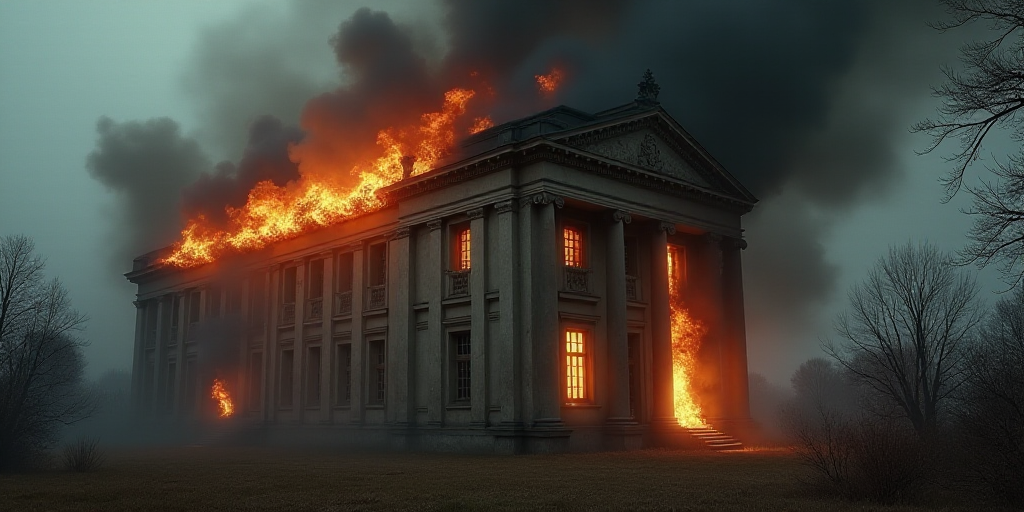Overview of the Attack
On Sunday, Russia executed its most significant aerial assault on Ukraine since the war’s commencement, unleashing a barrage of drones and missiles that resulted in at least five fatalities and ignited a fire at Ukraine’s government headquarters in Kiev.
Damage and Casualties
- Government Headquarters: A journalist from AFP witnessed flames on the roof of the building where the cabinet meets, along with smoke in other parts of Kiev.
- Fatalities: At least five people, including a baby, lost their lives in the attack.
- Residential Building: An apartment complex in western Kiev suffered an attack, killing at least two individuals and injuring 18 others.
- Other Attacks: Bombardments targeted various regions of Ukraine, including Dnipropetrovsk and Zaporiyia. A woman died in an attack in Sumy, a border region with Russia.
Ukrainian Response and International Context
Ukraine’s Prime Minister, Yulia Sviridenko, confirmed the attack via Telegram, stating that rescuers are working to extinguish the fire. She emphasized, “We will rebuild the buildings, but we cannot recover the lives lost. The enemy terrorizes and kills our people daily across the country.”
This attack marks the first of its kind against Ukraine’s government headquarters since the conflict began. The assault involved helicopters dropping what appeared to be water containers on the roof while emergency services responded. The police cordoned off the surrounding area.
According to Ukraine’s air force, Russia launched over 800 drones and missiles against Ukraine during the night, marking the largest attack since February 2022. Defense systems neutralized or downed 747 drones and four missiles.
Despite no signs of Russia halting its offensive against the former Soviet republic, Moscow continues to demand conditions for a peace agreement that Ukraine deems unacceptable.
International Involvement and Reactions
Following pledges from several European countries, led by France and the UK, to deploy forces in Ukraine should a peace agreement materialize, Russia labeled these security guarantees as “unacceptable.”
More than twenty European nations have committed to overseeing a potential peace agreement with troops on the ground. Ukraine insists these guarantees, backed by Western forces, are essential for any peace accord and to prevent future Russian invasions.
However, Russian President Vladimir Putin maintains that the presence of Western forces in Ukraine is unacceptable and would be legitimate targets. Meanwhile, US President Donald Trump’s efforts to end the war have yielded no results.
Impact of the Conflict
Over three and a half years of fighting have claimed the lives of tens of thousands, forcing millions to flee their homes and devastating much of eastern and southern Ukraine. This conflict has been Europe’s bloodiest since World War II.
Key Questions and Answers
- What happened during the attack? Russia launched its largest aerial assault on Ukraine since the war began, targeting the government headquarters in Kiev with drones and missiles. The attack resulted in at least five fatalities, including a baby, and ignited a fire at the government building.
- What other attacks occurred? Bombardments struck various regions of Ukraine, including Dnipropetrovsk and Zaporiyia. A woman died in an attack in Sumy, a border region with Russia.
- How did Ukraine respond? Prime Minister Yulia Sviridenko confirmed the attack and stated that rescuers are working to extinguish the fire. She emphasized the loss of lives and the ongoing terror inflicted by Russia.
- What are the international implications? Several European countries pledged to deploy forces in Ukraine should a peace agreement be reached. Russia deemed these security guarantees “unacceptable.”
- What is the current status of peace negotiations? Despite ongoing efforts, including those by US President Donald Trump, no resolution to the conflict has been achieved. Russia insists on conditions for a peace agreement that Ukraine finds unacceptable.






